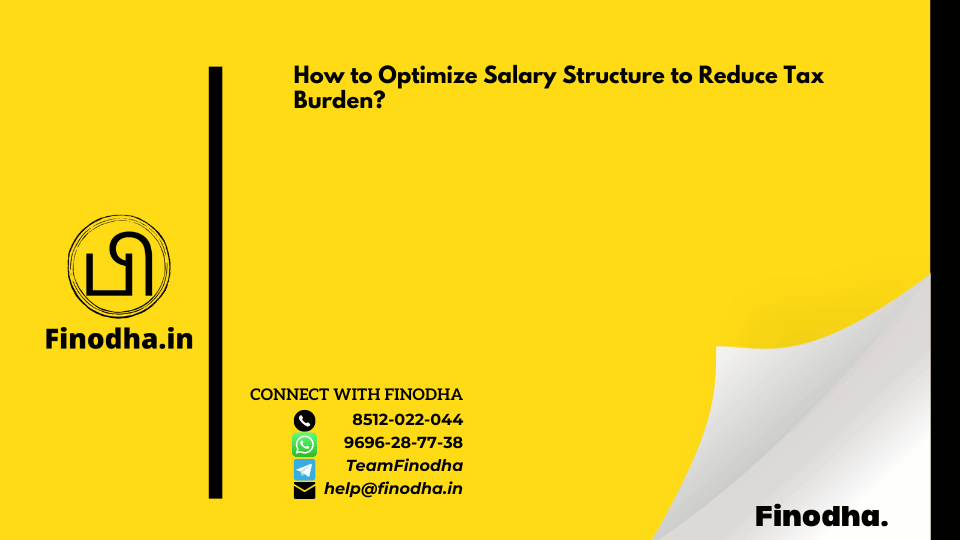Important Keyword: Income from salary, Salary Components, Salary Income.
Table of Contents
How to Optimize Salary Structure to Reduce Tax Burden?
Crafting a strategic salary structure can be a potent tool in the arsenal of tax-saving measures for individuals. By leveraging the various components of your salary and making the most of available deductions during the tax filing process, you can significantly lighten your tax burden. This article aims to shed light on effective strategies for optimizing your salary structure to minimize your tax liability.
What are the Allowances and Deductions that can Reduce the Tax Liability?
Several salary components can effectively reduce your tax burden when strategically utilized:
House Rent Allowance (HRA) is a vital component of an employee’s salary, especially for those residing in rented accommodations. To avail of the tax exemption on HRA, it must be a part of the salary structure. The exemption amount is determined as follows:
- Actual HRA Received: The amount of HRA received from the employer.
- Actual Rent Paid – 10% of Basic Salary: The actual rent paid minus 10% of the basic salary.
- 50% of Basic Salary + Dearness Allowance (DA) (40% for non-metro cities): Fifty percent of the basic salary and DA for employees residing in metro cities, or forty percent for non-metro cities.
Children Education Allowance (CEA) is provided to support an employee’s child’s education. An annual allowance of INR 1200 per child, up to a maximum of two children, is exempt from taxation. Additionally, tuition fees paid for a child’s education can be claimed as a deduction under Section 80C of the Income Tax Act.
Hostel Expenditure Allowance, amounting to INR 3600 per annum per child, is provided to meet hostel expenses for an employee’s children, with a maximum exemption for two children.
Phone Bill Reimbursement covers broadband Internet and mobile phone expenses. However, this benefit may only be extended to specific employees.
Food Coupons, with a value of up to INR 50 per meal, are provided to meet food expenses. Employees can claim up to INR 26,400 annually as an exemption.
Leave Travel Allowance (LTA) assists employees with travel expenses incurred while traveling with their families in India. Exemptions are provided for economy air travel or AC railway travel for two journeys in a block of four calendar years.
Gift Vouchers valued at up to INR 5000 annually can be claimed as an exemption if provided by the employer.
Newspaper/Journal Allowance can be claimed for subscriptions to gain additional knowledge relevant to the job.
Uniform Allowance covers expenses for purchasing and maintaining work uniforms.
Car Maintenance Allowance provides exemptions for car expenses, based on ownership. Employees using employer-owned cars pay taxes on prerequisites, while owners can claim exemptions of INR 2,700 or INR 3,300 per month, depending on engine capacity.
How are these Allowances Calculated in a Salary?
Certainly! Let’s consider two scenarios for Ms. Mehra’s salary structure to illustrate how she can maximize tax savings:
| Particulars | Salary Structure 1 | Salary Structure 2 |
| Basic Salary | 5,00,000 | 4,00,000 |
| + HRA | 3,00,000 | 2,00,000 |
| + Provident Fund (12%) | 60,000 | 48,000 |
| (+) Standard Allowance (Conveyance allowance + medical reimbursement) | 40,000 | 40,000 |
| (+) Leave Travel Allowance | 30,000 | 30,000 |
| (+) Other Allowances | 70,000 | 2,82,000 |
| Total | 10,00,000 | 10,00,000 |
| (-) Exempted HRA | 2,50,000 | 2,00,000 |
| (-) Standard Allowance | 40,000 | 40,000 |
| (-) Leave Travel Allowance | 30,000 | 30,000 |
| (-) Other allowances Meal allowance Mobile bill reimbursement Gift voucher Child’s education allowance Child’s hostel allowance Newspaper/Journal allowance Internet Bill reimbursement | – | 26,400 10,000 5,000 2,400 7,200 16,000 12,000 |
| Total taxable Salary | 6,80,000 | 6,51,000 |
| Less: Profession Tax Paid | 2,500 | 2,500 |
| Income under the head Salary | 6,77,500 | 6,48,500 |
| (-) Deductions under Section 80C | 1,50,000 | 1,50,000 |
| Total Taxable Income | 5,27,500 | 4,98,500 |
| Tax on income | 18,720 | 12,920 |
| Saving in tax | 5,800 |
Which ITR Form to file?
Exactly! Choosing the right Income Tax Return (ITR) form is crucial for accurate filing. Here’s a quick summary:
- ITR 1 (Sahaj):
- Applicable for individuals with income from:
- Salary/pension (up to INR 50 lakhs)
- One house property
- Other sources (excluding lottery winnings and income from race horses)
- Not applicable if income includes:
- Income from more than one house property
- Income from capital gains
- Income from business or profession
- Applicable for individuals with income from:
- ITR 2:
- Applicable for individuals and HUFs with income from:
- Salary/pension (any amount)
- More than one house property
- Capital gains
- Income from other sources (including lottery winnings and race horses)
- Not applicable if income includes:
- Income from business or profession
- Applicable for individuals and HUFs with income from:
- ITR 3:
- Applicable for individuals and HUFs with income from:
- Business or profession
- Salary/pension
- Capital gains
- Income from other sources
- Suitable for those with business or professional income in addition to other sources of income
- Applicable for individuals and HUFs with income from:
Choosing the correct ITR form ensures accurate reporting of income and compliance with tax regulations.
Read More: LTC Cash Voucher Scheme
Web Stories: LTC Cash Voucher Scheme
Official Income Tax Return filing website: https://incometaxindia.gov.in/





0 Comments